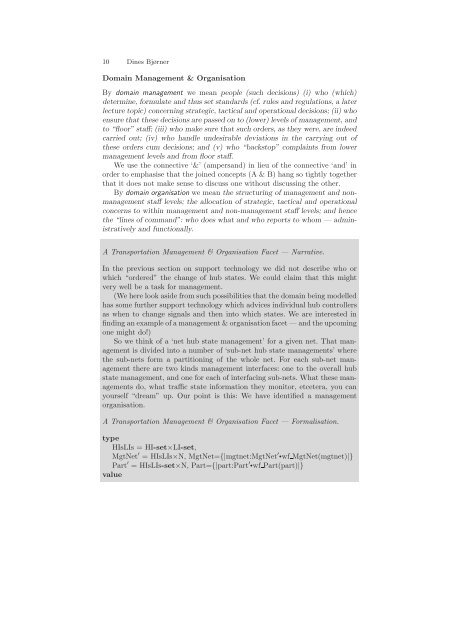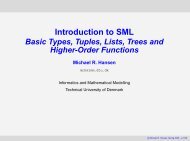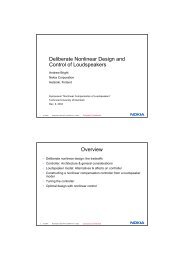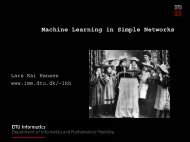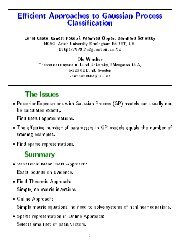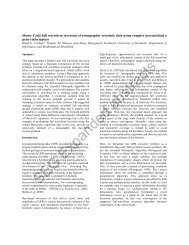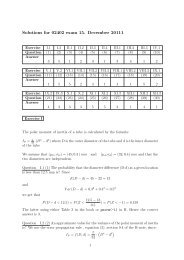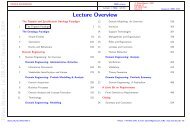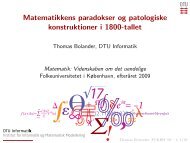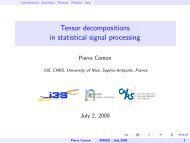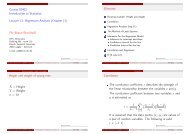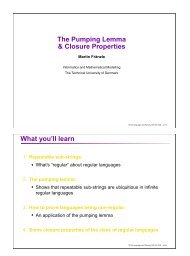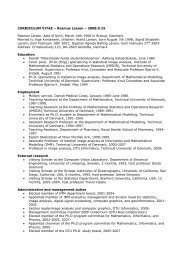the Ugo Montanari Festschrift paper - DTU Informatics
the Ugo Montanari Festschrift paper - DTU Informatics
the Ugo Montanari Festschrift paper - DTU Informatics
Create successful ePaper yourself
Turn your PDF publications into a flip-book with our unique Google optimized e-Paper software.
10 Dines Bjørner<br />
Domain Management & Organisation<br />
By domain management we mean people (such decisions) (i) who (which)<br />
determine, formulate and thus set standards (cf. rules and regulations, a later<br />
lecture topic) concerning strategic, tactical and operational decisions; (ii) who<br />
ensure that <strong>the</strong>se decisions are passed on to (lower) levels of management, and<br />
to “floor” staff; (iii) who make sure that such orders, as <strong>the</strong>y were, are indeed<br />
carried out; (iv) who handle undesirable deviations in <strong>the</strong> carrying out of<br />
<strong>the</strong>se orders cum decisions; and (v) who “backstop” complaints from lower<br />
management levels and from floor staff.<br />
We use <strong>the</strong> connective ‘&’ (ampersand) in lieu of <strong>the</strong> connective ‘and’ in<br />
order to emphasise that <strong>the</strong> joined concepts (A & B) hang so tightly toge<strong>the</strong>r<br />
that it does not make sense to discuss one without discussing <strong>the</strong> o<strong>the</strong>r.<br />
By domain organisation we mean <strong>the</strong> structuring of management and nonmanagement<br />
staff levels; <strong>the</strong> allocation of strategic, tactical and operational<br />
concerns to within management and non-management staff levels; and hence<br />
<strong>the</strong> “lines of command”: who does what and who reports to whom — administratively<br />
and functionally.<br />
A Transportation Management & Organisation Facet — Narrative.<br />
In <strong>the</strong> previous section on support technology we did not describe who or<br />
which “ordered” <strong>the</strong> change of hub states. We could claim that this might<br />
very well be a task for management.<br />
(We here look aside from such possibilities that <strong>the</strong> domain being modelled<br />
has some fur<strong>the</strong>r support technology which advices individual hub controllers<br />
as when to change signals and <strong>the</strong>n into which states. We are interested in<br />
finding an example of a management & organisation facet — and <strong>the</strong> upcoming<br />
one might do!)<br />
So we think of a ‘net hub state management’ for a given net. That management<br />
is divided into a number of ‘sub-net hub state managements’ where<br />
<strong>the</strong> sub-nets form a partitioning of <strong>the</strong> whole net. For each sub-net management<br />
<strong>the</strong>re are two kinds management interfaces: one to <strong>the</strong> overall hub<br />
state management, and one for each of interfacing sub-nets. What <strong>the</strong>se managements<br />
do, what traffic state information <strong>the</strong>y monitor, etcetera, you can<br />
yourself “dream” up. Our point is this: We have identified a management<br />
organisation.<br />
A Transportation Management & Organisation Facet — Formalisation.<br />
type<br />
HIsLIs = HI-set×LI-set,<br />
MgtNet ′ = HIsLIs×N, MgtNet={|mgtnet:MgtNet ′ • wf MgtNet(mgtnet)|}<br />
Part ′ = HIsLIs-set×N, Part={|part:Part ′ • wf Part(part)|}<br />
value


